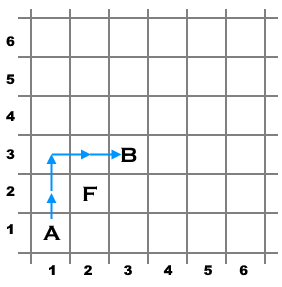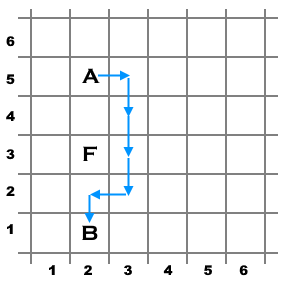| Codeforces Round 731 (Div. 3) |
|---|
| Finished |
There are three cells on an infinite 2-dimensional grid, labeled $$$A$$$, $$$B$$$, and $$$F$$$. Find the length of the shortest path from $$$A$$$ to $$$B$$$ if:
- in one move you can go to any of the four adjacent cells sharing a side;
- visiting the cell $$$F$$$ is forbidden (it is an obstacle).
The first line contains an integer $$$t$$$ ($$$1 \le t \le 10^4$$$) — the number of test cases in the input. Then $$$t$$$ test cases follow. Before each test case, there is an empty line.
Each test case contains three lines. The first one contains two integers $$$x_A, y_A$$$ ($$$1 \le x_A, y_A \le 1000$$$) — coordinates of the start cell $$$A$$$. The second one contains two integers $$$x_B, y_B$$$ ($$$1 \le x_B, y_B \le 1000$$$) — coordinates of the finish cell $$$B$$$. The third one contains two integers $$$x_F, y_F$$$ ($$$1 \le x_F, y_F \le 1000$$$) — coordinates of the forbidden cell $$$F$$$. All cells are distinct.
Coordinate $$$x$$$ corresponds to the column number and coordinate $$$y$$$ corresponds to the row number (see the pictures below).
Output $$$t$$$ lines. The $$$i$$$-th line should contain the answer for the $$$i$$$-th test case: the length of the shortest path from the cell $$$A$$$ to the cell $$$B$$$ if the cell $$$F$$$ is not allowed to be visited.
7 1 1 3 3 2 2 2 5 2 1 2 3 1000 42 1000 1 1000 1000 1 10 3 10 2 10 3 8 7 8 3 7 2 1 4 1 1 1 1 344 1 10 1 1
4 6 41 4 4 2 334
 An example of a possible shortest path for the first test case.
An example of a possible shortest path for the first test case.  An example of a possible shortest path for the second test case.
An example of a possible shortest path for the second test case.
| Name |
|---|




